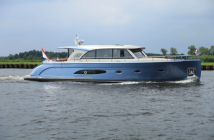The Coast Guard has convened a formal Marine Board of Investigation into the loss of the duck boat that sank on July 19 with the loss of 17 lives near Branson, Missouri. A Marine Board of Investigation is the highest-level investigation in the Coast Guard, and it’s only the fifth to be convened in the past decade.
Meanwhile, two different families of drowning victims in the tragedy have sued Ride the Ducks Branson, the company operating the duck boat fleet there, charging that they are “death traps” and that the operators knew about safety problems for years and did nothing to make them safer.
The Kansas City Star quotes an attorney for one of the families as saying “It is an absolute disgrace that those fatal designs were, in a very public way, pointed out over 16 years ago, and the duck boat industry did nothing. That is outrageous.” After a duck boat sinking in 1999 in Arkansas, the National Transportation Safety Board said the boats need to get rid of overhead canopies that can trap passengers if the boat starts sinking; it also recommended that the boats be retrofitted with more buoyancy so that the odds of sinking are reduced. One of the new suits asks for $100 million in damages in a wrongful-death action.
For its part, the NTSB has completed its initial review of video recordings from the duck boat. They showed that the captain checked the weather before the boat left its launch ramp and then made two calls on his handheld VHF radio before the boat sank. The contents of the radio calls were unintelligible.
The NTSB developed a timeline from recordings on an SB card and a hard drive from the boat’s digital video camera system that divers recovered after the accident.
The timeline starts at 6:28 p.m. local time when someone stepped on the boat and told the crew to take the water portion of the tour first. Normally the tour starts on land, with a driver in charge, and then enters Table Rock Lake, where the boat captain takes over. A minute after this change, the captain referred to looking at the weather radar before the trip.
At 6:50, near the boat ramp, the captain began a safety briefing, showing the location of emergency exits as well as the location of life jackets. He then demonstrated how to use a life jacket and pointed out the location of life rings.
At 6:55 the boat entered the lake. The water appeared calm at this time. During the next four minutes, the captain allowed four different children to sit in the captain’s seat while he observed.
At 7, whitecaps rapidly built up on the water and the wind increased. (The Branson area came under a severe thunderstorm warning just after 6:30. CNN reported that radar showed the first wind gusts hitting the lake about 6:59.) At this time the driver lowered the clear plastic side curtains, port and starboard. The captain made a comment about the storm and made the first radio call.
At 7:04 the bilge alarm went off, but the captain apparently turned the alarm off. A minute later, the captain made the second radio call. Video then showed water occasionally splashing into the boat’s passenger compartment.
At 7:07 the bilge alarm went off again. The recording ended one minute later while the boat was still on the surface of the water.
Ride the Ducks Branson says it sank at 7:09. Read the NTSB timeline here:
https://www.ntsb.gov/news/press-releases/pages/nr20180727.aspx
https://www.kansascity.com/news/state/missouri/article215767540.html




